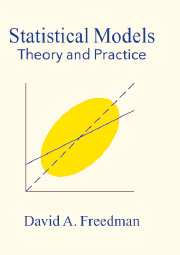Book contents
5 - Path Models
Published online by Cambridge University Press: 05 June 2012
Summary
Stratification
A path model is a graphical way to represent a regression equation or several linked regression equations. These models, developed by the geneticist Sewell Wright, are often used to make causal inferences. We will look at a couple of examples and then explain the logic, which involves response schedules and the idea of stability under interventions.
Blau and Duncan (1967) are thinking about the stratification process in the United States. According to Marxist scholars of the time, the US is a highly stratified society. Status is determined by family background, and transmitted through the school system. Blau and Duncan have data in their chapter 2, showing that family background variables do influence status–but the system is far from deterministic. The US has a permeable social structure, with many opportunities to succeed or fail. Blau and Duncan go on to develop the path model shown in figure 1 on the next page, in order to answer questions like these:
“how and to what degree do the circumstances of birth condition subsequent status? and, how does status attained (whether by ascription or achievement) at one stage of the life cycle affect the prospects for a subsequent stage?” [p. 164]
The five variables in the diagram are son's occupation, son's first job, son's education, father's occupation, and father's education. Data come from a special supplement to the March 1962 Current Population Survey. The respondents are the sons (age 20–64), who answer questions about current job, first job, and parents.
Information
- Type
- Chapter
- Information
- Statistical ModelsTheory and Practice, pp. 75 - 108Publisher: Cambridge University PressPrint publication year: 2005
Accessibility standard: Unknown
Why this information is here
This section outlines the accessibility features of this content - including support for screen readers, full keyboard navigation and high-contrast display options. This may not be relevant for you.Accessibility Information
- 1
- Cited by
